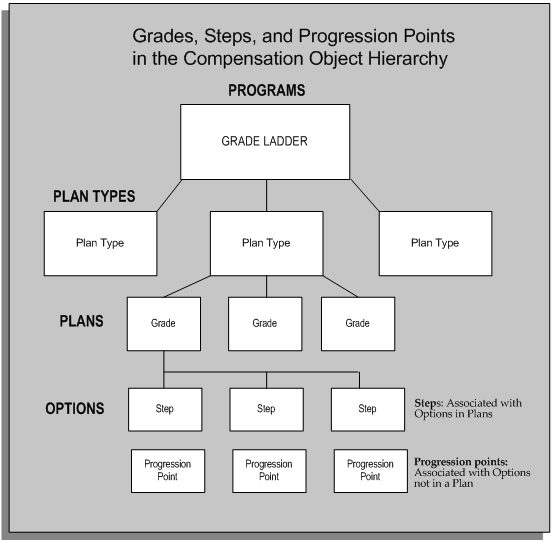Grade/Step Progression and the Total Compensation Data Model
Grade/Step Progression and the Total Compensation Data Model
The Grade/Step Progression process maps the grade ladder structure to the Total Compensation data model. When you create grade ladders, grades, steps, progression points and salary rates using the Grade Ladder Setup pages, the system creates corresponding objects, such as programs and plans. The object mapping is shown below:
| This Grade/Step Progression object ... | ... Maps to this compensation object |
|---|---|
| Grade Ladder | Program |
| Grade in Ladder | Plan in Program |
| Grade | Plan |
| Steps in Grade | Options in Plan |
| Progression Points | Options |
| Default Salary Rates | Standard Rates |
| Criteria Salary Rates | Variable Rates |
| Progression Rules | Eligibility Profiles |
Caution: You can create the eligibility profiles (used for progression rules) using the Participation Eligibility Profiles window. However, you must create all other Grade/Step Progression objects using the Total Compensation Setup Wizard . Unless you have extensive knowledge of the Total Compensation model and Plan Design setup, we strongly recommend that you perform all ongoing grade ladder administration and maintenance using the Total Compensation Setup Wizard.
The following graphic illustrates the grade ladder structure within the Compensation Hierarchy.

Mapping the Grade/Step Progression structure to the Total Compensation data model enables the automatic progression of grades and steps, and optionally, automatic updates to salary rates.
For more information on the Compensation Hierarchy, see: Plan Design, Oracle HRMS Compensation and Benefits Management Guide
If you are not using Grade/Step Progression, you can create your grade, step, progression point, and pay rate information using the Grade Rate, Pay Scale, Scale Rate and Grade Scale windows. This will not create corresponding compensation objects.